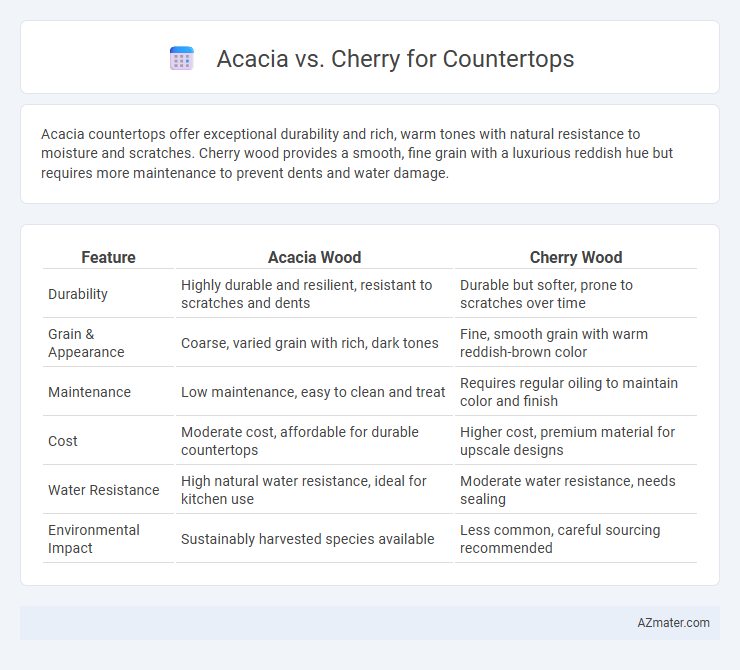Acacia countertops offer exceptional durability and rich, warm tones with natural resistance to moisture and scratches. Cherry wood provides a smooth, fine grain with a luxurious reddish hue but requires more maintenance to prevent dents and water damage.
Table of Comparison
| Feature | Acacia Wood | Cherry Wood |
|---|---|---|
| Durability | Highly durable and resilient, resistant to scratches and dents | Durable but softer, prone to scratches over time |
| Grain & Appearance | Coarse, varied grain with rich, dark tones | Fine, smooth grain with warm reddish-brown color |
| Maintenance | Low maintenance, easy to clean and treat | Requires regular oiling to maintain color and finish |
| Cost | Moderate cost, affordable for durable countertops | Higher cost, premium material for upscale designs |
| Water Resistance | High natural water resistance, ideal for kitchen use | Moderate water resistance, needs sealing |
| Environmental Impact | Sustainably harvested species available | Less common, careful sourcing recommended |
Introduction to Acacia and Cherry Countertops
Acacia and cherry wood are popular choices for countertops due to their durability and rich aesthetic appeal. Acacia offers a dense, water-resistant surface with distinctive grain patterns, making it ideal for high-traffic kitchen areas. Cherry countertops are prized for their smooth texture and warm, reddish-brown tones that deepen over time, enhancing the elegance of any interior space.
Key Differences Between Acacia and Cherry Wood
Acacia wood features high natural resistance to moisture and scratches, making it ideal for durable countertops, while cherry wood offers a smoother texture and rich reddish-brown hue that deepens with age. Acacia displays prominent grain patterns and a varied color palette ranging from light amber to dark brown, contrasted by cherry's uniform grain and warm, consistent color. The hardness of acacia (rated around 2180 on the Janka scale) surpasses cherry (approximately 950), influencing longevity and maintenance needs in countertop applications.
Durability and Hardness Comparison
Acacia wood offers high durability with a Janka hardness rating of approximately 1,700, making it resistant to dents and scratches, ideal for kitchen countertops subject to heavy use. Cherry wood, with a Janka hardness around 950, is softer than Acacia but develops a rich patina over time, improving its appearance while being moderately durable. Overall, Acacia is better suited for countertops requiring superior hardness and resistance to wear, whereas Cherry provides aesthetic warmth with moderate durability.
Aesthetic Appeal: Grain, Color, and Texture
Acacia countertops feature a striking grain pattern with rich, varied hues ranging from golden brown to deep reddish tones, offering a warm and rustic aesthetic. Cherry wood boasts a smooth, fine grain and a deepening reddish-brown color that matures beautifully over time, providing a classic and elegant look. Both woods offer distinctive textures; Acacia presents a more pronounced, natural texture ideal for bold statement pieces, while Cherry's smoother finish suits refined, sophisticated kitchen designs.
Cost Analysis: Acacia vs Cherry
Acacia countertops typically cost between $30 to $50 per square foot, offering a budget-friendly option compared to cherry wood, which ranges from $40 to $70 per square foot due to its premium quality and durability. Maintenance expenses for acacia are generally lower, as it resists scratches and water damage better than cherry, which may require more frequent refinishing. Over time, acacia provides a cost-effective solution for homeowners seeking aesthetic appeal without the higher investment associated with cherry countertops.
Maintenance Requirements for Both Woods
Acacia countertops require regular oiling to maintain their moisture resistance and prevent cracking, while cherry wood demands less frequent oiling but benefits from periodic waxing to preserve its rich color and smooth texture. Both woods are susceptible to scratches and dents, with cherry being softer and more prone to surface damage, necessitating gentle cleaning and protective measures to maintain longevity. Proper maintenance, including immediate wipe-up of spills and use of cutting boards, is essential for both acacia and cherry countertops to retain their durability and aesthetic appeal.
Sustainability and Environmental Impact
Acacia countertops are highly sustainable due to their rapid growth rate and ability to regenerate quickly after harvesting, making them an eco-friendly wood choice. Cherry wood, while durable and prized for its rich color, often comes from slower-growing trees and less renewable sources, which may contribute to higher environmental impacts. Choosing Acacia supports better forest management practices and reduces deforestation risks compared to the more resource-intensive cherry wood.
Suitability for Kitchen and Bathroom Use
Acacia countertops boast exceptional durability and resistance to moisture, making them highly suitable for both kitchen and bathroom environments where frequent water exposure occurs. Cherry wood offers a smooth, warm finish and moderate resistance to humidity but requires regular maintenance to prevent warping and damage in damp areas. For kitchen and bathroom use, acacia's natural hardness and water resistance provide a more practical and long-lasting solution compared to cherry wood.
Pros and Cons of Acacia Countertops
Acacia countertops offer a rich, warm appearance with natural variations that add character and uniqueness to kitchen surfaces, making them a popular choice for rustic or modern designs. They are highly durable, resistant to scratches and dents, and have natural antibacterial properties, but require regular sealing and maintenance to prevent water damage and staining. Compared to cherry wood, acacia tends to be more affordable and sustainable, though it may darken unevenly over time and is less resistant to heat.
Pros and Cons of Cherry Countertops
Cherry countertops offer a rich, warm tone that deepens with age, providing a classic and elegant appearance highly valued in kitchen design. Their hardness and durability make them resistant to scratches and dents, although they require regular maintenance to prevent moisture damage and fading from direct sunlight. The primary drawback of cherry countertops is their susceptibility to darkening unevenly over time, which can lead to inconsistency in color and requires careful sealing and upkeep.

Infographic: Acacia vs Cherry for Countertop
 azmater.com
azmater.com